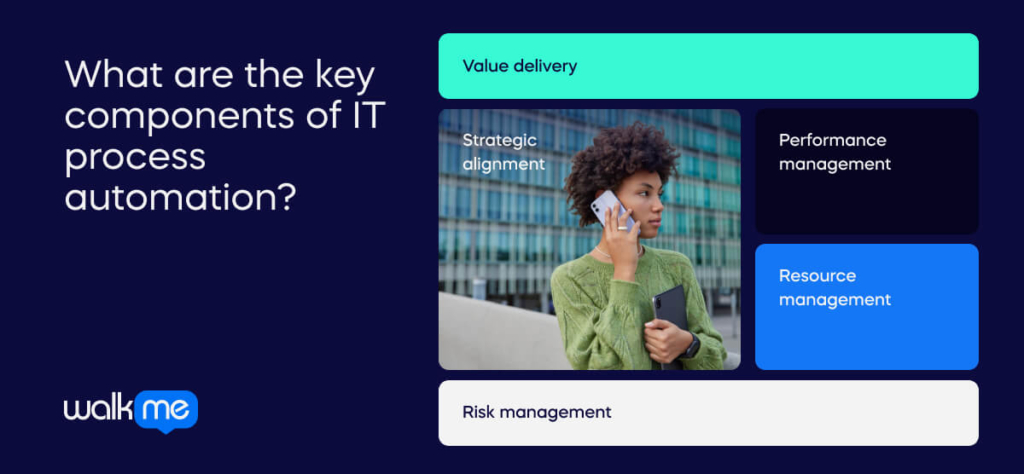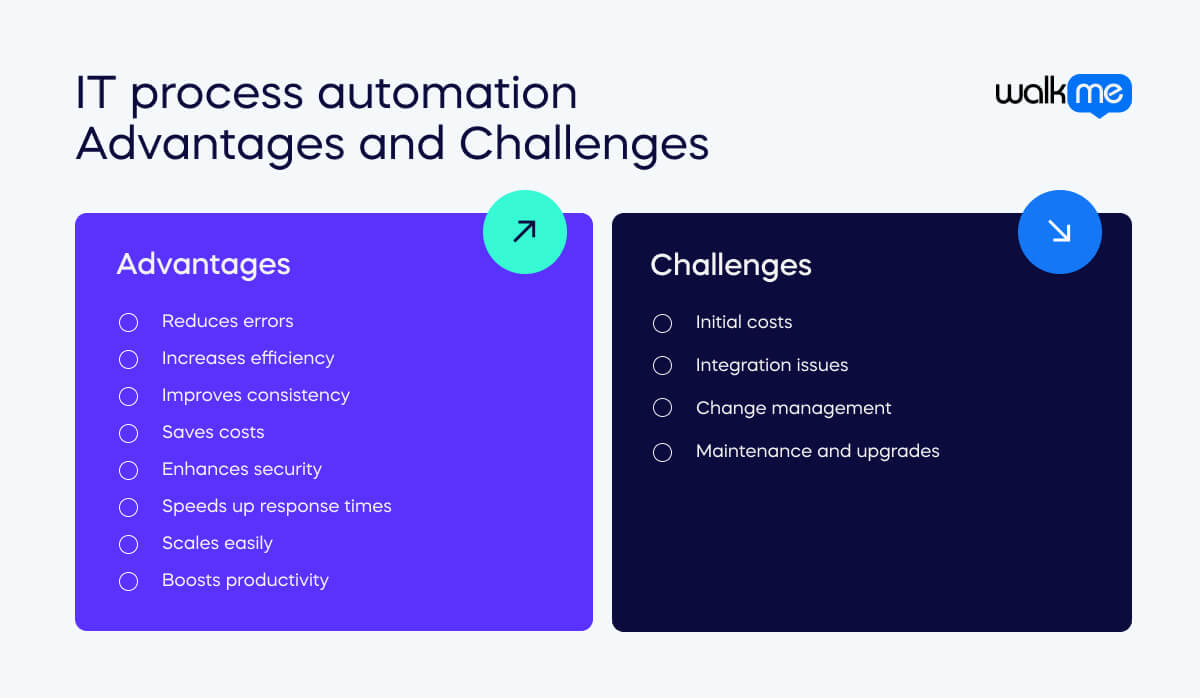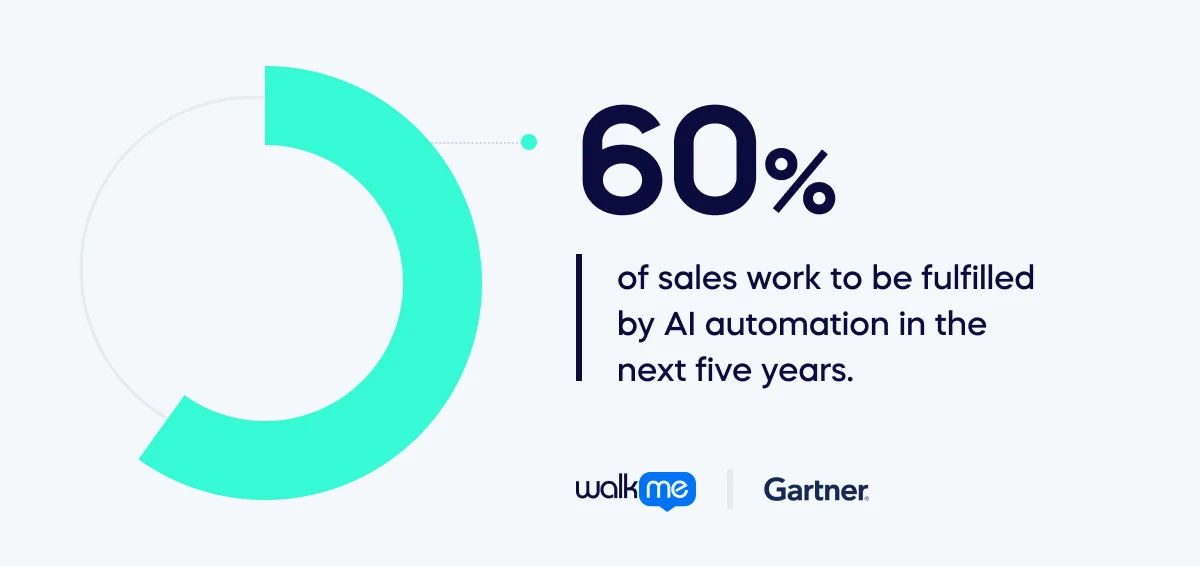What is IT process automation?
IT process automation means using technology to handle common IT tasks without needing people. This involves using special software to automate repetitive jobs, such as managing computer networks, processing data, or handling support requests. By automating these tasks, companies can work more efficiently, make fewer mistakes, and let IT workers focus on more important tasks.

Table of contents
- What is IT process automation?
- What are the key components of IT process automation?
- IT process automation vs robotic process automation (RPA)
- Use cases for IT process automation
- What are the advantages of IT process automation?
- What are the challenges of IT process automation?
- How can DAPs help with IT process automation?
A big advantage of IT process automation is that it smooths workflows. Automation tools can handle tasks such as system updates, backups, and security checks faster and more accurately than people. This speeds up work and makes IT services more reliable. It also helps companies manage their IT needs as they grow, allowing them to deal with more work without hiring extra staff. In short, IT process automation helps businesses work better and faster. It cuts down on the need for manual work, reduces costs from mistakes, and keeps IT systems running smoothly.
What are the key components of IT process automation?

Understanding the key parts of IT process automation helps one understand how it makes IT work better and faster. These parts work together to handle routine tasks automatically so IT staff can focus on more important jobs. Each part is important for ensuring that automation works well. Let’s examine the main components that make IT process automation effective and helpful.
Automation tools and software
These are special programs that perform routine IT tasks independently. They handle repetitive jobs like system updates, data backups, and security checks without needing people to do them. These tools make work faster and more accurate by always performing tasks the same way.
Processes and workflows
This is about the specific tasks and steps that are being automated. Each task must be clearly defined so the tools know exactly what to do. Well-defined steps help prevent mistakes and make the work run more smoothly.
Integration capabilities
Automation tools need to work well with other software and systems already in use. Integration allows different tools and systems to talk to each other and work together. This helps the automation fit into the existing IT setup, making everything work better.
Monitoring and reporting
Good automation includes ways to watch and report how the automated tasks are doing. Monitoring helps find any problems or slow areas, while reporting shows how well the automation works. This helps make quick fixes and keep everything running smoothly.
Security measures
Automation tools should have features to protect data and systems from unauthorized access. These security features protect sensitive information and ensure that automated tasks don’t create new problems. Strong security is important to keep IT operations safe and secure.
IT process automation vs robotic process automation (RPA)
IT process automation (ITPA) and robotic process automation (RPA) both help automate tasks, but they do different things.
- ITPA focuses on automating IT jobs like system updates and backups.
- RPA uses software robots to handle repetitive tasks in various business areas.
Let’s see how these two types of automation are different.
| IT process automation | Robotic process automation | |
| Definition | Using technology to do IT tasks automatically. This includes updating systems and backing up data without needing people. | Uses software robots to do repetitive tasks in different areas of a business. These bots work with various software to follow rules and complete tasks. |
| Focus | Automating IT tasks like managing networks and systems. It helps with technical jobs to keep IT running well. | Automating tasks in different business areas, like finance and HR. It handles jobs like entering data and processing transactions. |
| Techniques | Uses tools like scripts and system programs to handle IT tasks. It helps different IT systems work together better. | Uses software bots to copy human actions and work with different applications. It uses methods like screen-scraping to complete tasks. |
| Goals | To make IT work faster and more accurately by handling routine tasks. This cuts down on mistakes and lets IT staff focus on important work. | To improve business by automating repetitive tasks. This lowers costs, increases accuracy, and helps different departments work better. |
| Examples of use | Update software, back up data, and manage user accounts automatically. | Process invoices, handle employee records, and manage customer support by reading and entering information from emails. |
Use cases for IT process automation
IT process automation can make a big difference in different business situations. Whether keeping IT systems updated, saving data regularly, or managing user accounts, automation helps make these tasks easier. It’s helpful to see how automation works in real life. Here are three examples that show how automation can be used in different parts of a business.
System updates
System updates keep IT systems working well and securely. The automation tool checks for new updates and installs them automatically without needing people to do it. This keeps all software current with the latest features and security fixes. IT staff don’t have to spend time updating systems by hand, which lets them focus on other important tasks. Automated updates also help protect against security problems.
Data backups
Data backups ensure important information is saved regularly to avoid loss. The automation tool sets up and performs backups at scheduled times, like daily or weekly. This protects data from being lost due to accidents, system failures, or attacks. Staff don’t have to remember to back up data themselves, which reduces the risk of losing files. Automated backups also make it quick to restore data if something goes wrong.
User account management
User account management involves setting up, updating, and removing user accounts on IT systems. The automation tool does these tasks automatically when there are changes, like new hires or role changes. This keeps user accounts accurate and up to date, which helps maintain security and proper access. IT staff save time and avoid mistakes by letting automation handle these tasks. It also ensures that users have the right access as their roles change.

What are the advantages of IT process automation?
IT process automation brings many benefits to businesses. By automating routine IT tasks, companies can make their work faster and more accurate. This saves time and money while also making systems more reliable and secure. Let’s look at the main advantages of IT process automation in more detail.
Reduces errors
Automation performs tasks very accurately, so there are fewer mistakes than when done by hand. This helps ensure IT jobs are done right every time. Fewer mistakes mean less time fixing problems and more reliable systems. Automation also prevents issues that can happen because of human error.
Increases efficiency
Automation speeds up repetitive tasks, like updating systems and backing up data, saving time compared to doing these tasks manually. This lets IT staff focus on more important work. Increased efficiency helps the business run smoother and faster. Automation also enables tasks to be done anytime without needing people.
Improves consistency
Automated tasks are done the same way every time, which keeps IT processes consistent. This means fewer surprises and makes IT operations more stable and predictable. Consistency also ensures that all tasks meet the same quality standards, improving overall work.
Saves costs
By automating routine IT tasks, businesses need fewer workers for these jobs. This cuts labor costs and lets the company use money for other important things. Over time, these savings add up. Automation also helps avoid the costs of mistakes and delays made by people.
Enhances security
Automation helps keep systems secure by regularly applying updates and fixes. This ensures security measures are always up to date, protecting the business from risks and attacks. Automated updates also lower the chance of security problems and make systems safer.
Speeds up response times
Automated systems quickly handle tasks like support tickets or managing user accounts. This speeds up how fast things get done and improves the overall experience. Faster responses keep operations running well. Automation also ensures tasks are finished on time, even when things are busy.
Scales easily
As a business grows, automation can handle more tasks and data without needing more staff. This makes it easier to manage more work as the company gets bigger. Scaling up becomes simpler and more cost-effective. Automation also helps businesses adjust quickly to new needs.
Boosts productivity
By taking over routine tasks, automation lets IT staff focus on more important projects. This boosts overall productivity and helps the business reach its goals. Staff can spend more time on work, which allows the company to grow and leads to better results.
What are the challenges of IT process automation?
While automation can be very helpful, it also has some difficulties. Knowing about these challenges is important to ensure its smooth operation. Let’s explore the issues that might come up with IT process automation.
Initial costs
Setting up IT process automation can be costly at first. Companies must buy software, train staff, and maybe get expert help. These upfront costs can be high, and it may take a while before the benefits of automation outweigh the expense.
Integration issues
Connecting automation tools with existing systems can be tricky. Adjustments might be needed to make everything work together smoothly. This can take time and may require special skills to set up properly.
Change management
Switching to automation means changing how things are done. This can be hard for employees who are used to the old ways. Good training and support are needed to help everyone adapt to the new system.
Maintenance and upgrades
Even after setting up automation, it needs ongoing maintenance to keep it working well. This includes updating the system and fixing any problems that come up. Keeping up with these tasks can be challenging and needs regular attention.
How can DAPs help with IT process automation?

Digital adoption platforms (DAPs) can improve IT process automation. Businesses can use a DAP to set up and manage automation more easily. The platform provides tools and support to help companies get the most from their automation. Let’s see how DAPs help improve IT process automation and make it more effective in different business situations.
Guided workflows
Digital adoption platforms help with IT process automation by showing users step-by-step how to use new systems. They provide simple instructions and helpful visual guides, ensuring users understand each part of the process. This makes using the new systems easier and helps everyone quickly get the hang of it.
Onboarding assistance
When new users start with automation tools, digital adoption platforms offer clear instructions and support. They provide easy tutorials and tips to help users learn quickly. This makes getting used to the new systems easier and less stressful, so users feel confident and ready to start.
Real-time help
While users work with automated systems, digital adoption platforms provide real-time support. They offer quick answers to questions and help solve any problems that arise. This makes users feel more confident and ensures that any automation issues are fixed immediately so work can continue smoothly.